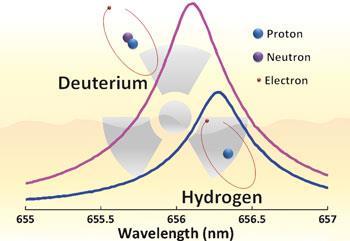A handheld device for nuclear inspectors to measure uranium-235 levels
A portable forensic device to detect nuclear isotopes intended for use in weapons has been made by scientists from Canada. The method was miniaturised without compromising its sensitivity, making it suitable for use by nuclear safeguard inspectors travelling the world.
The device designed by Fran?ois Doucet, from the National Research Council Canada, and colleagues, combines laser induced breakdown spectroscopy (LIBS) with chemometrics (statistical analysis). It can produce instant results of uranium-235/uranium-238 and deuterium/hydrogen isotope ratios.
Uranium-235 enrichment of 0.7-4.5 per cent can be considered normal for civil power generation, depending on the reactor type. Enrichment above 4.5 per cent can be suspected as being intended for military applications. ’The instrument needed to be sensitive enough to achieve the required detection limits and rugged enough to meet the field requirements of the International Atomic Energy Agency (IAEA),’ says Doucet. ’Our work demonstrates that present commercial components can achieve these requirements in a handheld LIBS sensing configuration,’ he adds.

When we think about forensic scientists, we usually picture people in crisp white lab coats in high tech laboratories, or gathering evidence at crime scenes behind yellow police tape. Some forensic scientists, however, have to travel a lot further than that. The IAEA is responsible for the safeguard of the world’s supply of uranium, plutonium and thorium. Their main purpose is to prevent nuclear proliferation. This often requires investigators to travel throughout a particular country to verify that nuclear levels are below the limit set.
At the moment, isotopic measurements are performed using techniques such as high resolution gamma spectroscopy or inductively coupled plasma-mass spectrometry. Unfortunately, when these techniques are miniaturised, it can compromise their analytical merit, and samples take a long time to prepare. Currently, IAEA inspectors use swipe kits to take samples, which are sent back to a lab. This gives very accurate results, but it takes a long time to get them, especially given the number of swipes taken each year.
’The technique reaches well beyond measurements under laboratory conditions and has a strong application oriented focus,’ says nuclear forensic expert Klaus Mayer, from the Joint Research Centre - Institute for Transuranium Elements, Germany. ’Doucet’s method has the potential to become a primary tool for safeguard inspectors and it could develop into an essential component of the nuclear forensics toolbox.’
Rebecca Brodie
Link to journal article
Determination of isotope ratios using Laser-Induced Breakdown Spectroscopy in ambient air at atmospheric pressure for nuclear forensicsFran?ois R. Doucet, Gregg Lithgow, Rick Kosierb, Paul Bouchard and Mohamad Sabsabi,?J. Anal. At. Spectrom., 2011, 26, 536DOI:10.1039/c0ja00199f






No comments yet